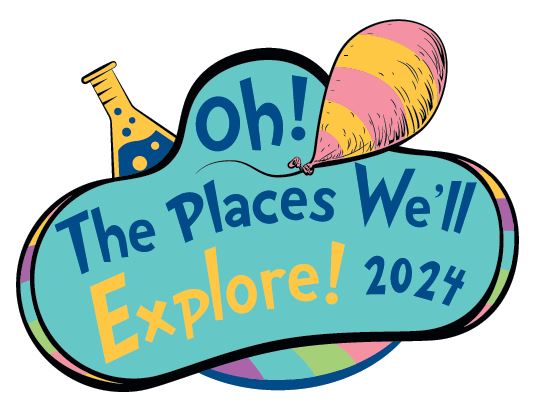
The CHEO Research Institute launched CHEO’s research strategic planning process in February 2020, driven by the following question: “What will success look like in 2024?” The strategic plan charts a path to success, with the theme of ‘Oh, The Places We’ll Explore! 2024’ focused on exploration.
In an amazing demonstration of partnership across CHEO, the CHEO Research Institute and the CHEO Foundation, our branding features the CHEO Foundation Bear, the bear’s debut in a strategic plan logo! Below are the four strategic directions of the plan.

We will grow. It will show.
Expand research in a sustainable fashion, measured through patient impact stories and tangible metrics of success
When we asked our stakeholders what success would look like by 2024, we repeatedly heard words like ‘expand’, ‘recruit’, ‘grow’, and ‘improve’. But how do we grow? Data we collected over the past nine months spoke to the need to grow smart. The CHEO Research Institute embraces an environment of continuous improvement and is always
asking… ’How can we do better’?
Strategic goals within “We will grow. It will show”
Recruit a minimum of 2-3 new scientists (and provide supporting resources) in current areas of strength that are tied to emerging areas of research excellence.
With new executive leadership and two Scientist vacancies, now is a perfect time to look at strategic recruitment. Since our last strategic plan, we have seen enormous success in many research areas while new areas of excellence (e.g., data science, cancer immunology) have emerged. We will recruit exceptional Scientists who can build upon our areas of research strength with demonstrated expertise in our emerging areas of excellence. Opportunities for joint recruitment of scientists with the University of Ottawa and other local health research institutes will be sought to further expand research talent at CHEO and build partnerships. As part of scientist recruitment, we will also ensure the necessary resources (e.g., staff, start-up funds, equipment) are available for the establishment of new researchers and the ongoing support required to help them succeed.
Increase external grant success, through more rigorous peer review processes and tailored grantsmanship mentoring.
Securing external grants is a key measure of our success and is essential for growth. We will continue to improve the grant success of our researchers through strengthened internal peer-review processes, as well as new grantsmanship processes and programs. These activities will help researchers best match their research projects to available opportunities and submit the highest quality grant applications to the right competition at the right time.
Develop and implement metrics that comprehensively outline the value of all research outputs and their impact.
Traditional metrics of academic success (e.g., publications, impact factor, patents, spin-off companies) are changing. The San Francisco Declaration on Research Assessment (DORA) is a set of recommendations to improve how the output of scientific research is evaluated. We would also like to use a more comprehensive set of measures that captures the broader impacts of our research. We will examine how research institutions implement DORA recommendations and improve how we measure our success.
Enhance current policies and processes to increase appointee accountability and support for institutional activities.
Our success depends on the support of our more than 300 appointed researchers, but what does it mean to be appointed? We will revise definitions for categories of appointment and clarify our expectations of appointees. We will develop clear guidelines so that our appointees can support and strengthen essential research activities, including mentorship, internal peer review, and knowledge translation.
Optimize our use of Research Institute space by matching research space to needs in an innovative approach.
As a result of the COVID 19 pandemic, we drastically changed how and where we worked: we are operating at less than 50% capacity and many researchers, trainees, and staff are working remotely. Lessons learned point to potential solutions for long-standing space challenges at the CHEO Research Institute. We will develop a new space management plan that considers ongoing initiatives and opportunities, while supporting and encouraging virtual work. In addition to addressing space challenges, this plan will improve our work environment and manage costs. As we did with patient engagement, such an innovative space management plan will position CHEO and the CHEO Research Institute as leader in this area.

As we teach, the heights we’ll reach!
Support the growth of child health researchers to achieve research excellence and improve patient care.
CHEO researchers look to us to support their research efforts. Above all other feedback we heard from stakeholders, was that success by 2024 requires us to develop the next generation of CHEO researchers. Most research institutes across Canada have robust education and mentorship programs to support research teams. We will learn from these programs and develop a unique CHEO research support infrastructure to best meet the needs of our researchers and their teams.
Strategic goals within “As we teach, the heights we’ll reach”
Develop and evaluate new programs for research education and training, mentorship, and internal grant support.
Informed by programs from other research institutes, we will build a dynamic research learning environment at CHEO. Emerging researchers are energetic and keen, but they often lack the guidance needed to succeed in the competitive world of academic research. New researchers can go from good to great with mentorship from an experienced researcher. Successful mentorship goes beyond a single individual, so we will also leverage the expertise within the Office of Research Services (e.g., grantsmanship, finance, human resources, and regulatory compliance). We will design and implement a suite of mentorship support services and regularly evaluate those services to ensure we are helping researchers chart a path to success.
Redefine and implement clear areas of child health research excellence and emerging excellence to improve impact and outcomes.
Our research is currently organized into three program areas and six themes, based on an external review conducted more than ten years ago. Much has changed in that time: we have developed new areas of strength while other areas of excellence are emerging. We will revisit this organizational structure and define areas of research excellence that will span bench, clinical, and data environments. This thematic structure will support more interdisciplinary collaboration, position teams with diverse expertise for funding opportunities, strengthen relationships with external research partners, and expand our international reputation.
Leverage the unique aspects of pediatric populations to expand collaborative research opportunities with CHEO partners, including Kids Come First member organizations.
As its research engine, the CHEO Research Institute has helped establish CHEO as a recognized leader in pediatric health research. CHEO is now redefining what it means to be a ‘hospital’ with its membership in the Kids Come First Health Team. Further, we are situated at the heart of health research in Canada’s capital along with University of Ottawa Faculties of Medicine and Health Sciences and The Ottawa Hospital (and its research institute), while also within close proximity to a number of Canadian government agencies. Combined, these offer unprecedented opportunities to partner with other organizations and achieve our vision and mission. We will establish partnerships with a variety of organizations and initiate collaborative projects that help us improve the health and wellbeing of children, youth, and families.
Explore opportunities for a dedicated research investigation unit for interventional trials.
Interventional trials often require procedures or assessments that are difficult to perform in the busy clinic setting of a hospital (e.g., intravenous infusions, gait and balance measurements). CHEO researchers require dedicated space and resources for this work, and other research institutes have created such investigational units. Beyond meeting the needs of our researchers, an investigational unit may attract industry-funded trials and other state-of-the-art research to CHEO. We will explore how other institutes have created such units, identifying facilitators and barriers, to determine the best way to provide dedicated research space for clinical trials (e.g., share space with a local unit vs. create our own).

Don’t give up, we need support from you all! Join us in research no matter how small.
Guide CHEO into becoming a research-intensive healthcare organization
Integrating research across CHEO has been an ongoing theme for our strategic plans. This integration requires the engagement of the entire CHEO community with co-leadership from researchers and management, mirroring the highly successful model for delivery of clinical care at CHEO. Thus, initiatives proposed in this plan will help CHEO to further integrate research into future strategic plans and weave it into the fabric of the organization.
Strategic goals within “…Join us in research no matter how small.”
Develop meaningful metrics to assess research engagement during annual performance reviews of all CHEO employees and medical staff.
Research success depends upon the participation of staff at CHEO, so it is important to consider how we measure and recognize their engagement with research. Empowering individuals to engage in research also drives research integration across CHEO from the ground up. Our work to develop organizational metrics of research integration will inform metrics that measure and recognize research engagement at the individual level. We will work with CHEO to tailor metrics to best fit job descriptions and opportunities for research engagement.
Create and evaluate a pilot CHEO Research Champion program, in a minimum of two areas of the hospital.
Research can often be viewed as ‘yet another thing’ a busy clinician or hospital employee is asked to do, rather than the key to providing the best service and clinical care. Thus, for research to succeed in a busy clinical setting it must be championed. Indeed, our most successful clinical research programs are rooted in broad buy-in from frontline providers. Research Champions are CHEO-based individuals who promote research, act as local points of contact, and liaise between CHEO and the Research Institute. We will draw from the experiences of research-intensive clinical programs (e.g., genetics, gastroenterology, emergency department) to define the roles and responsibilities of a Research Champion. We will then recruit Research Champions and evaluate their impact on integrating research within their clinical area.
Ensure that all CHEO children, youth and families will be given the opportunity to participate in research by implementing a CHEO permission to contact program, and that their participation is easily searchable in EPIC.
Informed consent is required for all clinical research, and there are different ways to seek consent from patients and families for a potential research project. At CHEO we use an “opt-in” model, meaning that patients and families have to provide their consent to be approached about a research project. However, this process is not formalized and many eligible patients do not get the opportunity to consider research that may be of interest to them. CHEO has already piloted a ‘permission to contact’ program in select clinical units, and this experience will guide the development of a hospital-wide program. Implementation of a permission to contact program will ensure that every patient and family presenting to CHEO is offered the opportunity to be contacted about research projects that may be relevant to their care. This information will be reflected in their EPIC record so that CHEO clinicians and staff are aware of a patient’s desire to be contacted about research and any research projects for which they have consented to participate.
CHEO Research Strategy metrics will be reflected in the next CHEO strategic plan and will be reviewed regularly at the hospital Executive and Board meetings
For research to be integrated across CHEO, there must be accountability and ownership at the Executive and Board levels. Under the leadership of the Vice President of Research at CHEO, relevant research performance metrics will be identified that can integrated into the strategic planning and regularly reviewed. Along with new metrics evaluating staff engagement in research, this ensures that research is considered across the entire organization from hospital leadership to front-line staff.

One tech, two tech, old tech, new tech.
Integrate technology to streamline communications, work processes, and facilitate research using digital means
Our 2020 operational review identified the need to adopt or improve technology solutions to operate efficiently. How can we leverage technology, digital solutions, and our own data to maximize research opportunities and support organizational growth?
Strategic goals within “One tech, two tech, old tech, new tech.”
Complete an extensive external IT review resulting in a solution-based
report and implement recommended solutions.
The IT infrastructure of the Research Institute is maintained by CHEO and our technology solutions have been adopted as needs arose. However this
IT adoption has been responsive, not planned. The continued growth of CHEO research requires a comprehensive IT plan. The Research Institute will conduct a third-party review of CHEO IT systems, perform a research needs assessment, and develop a unified approach that supports stronger internal communications, virtual work and serves us better now and through future growth
Increase accessibility of datasets to support research projects on a unified data platform.
Research data is often stored in different locations or platforms, making it difficult to access and hampering research efficiency, especially when working remotely. Research data includes everything from imaging scans, to clinical data from EPIC, and survey data from RedCap. Further, the newly launched CHEO Data Warehouse provides an unparalleled opportunity to facilitate research and improve clinical care. Informed by our IT plan, we will develop comprehensive data platforms to facilitate access to all available data.
Optimize external communications so CHEO Research becomes a real-time, trusted community resource for families and donors.
Patients and families love the ‘CHEO Discovery Minute’ videos and have asked for more digital content about CHEO research. This goal will work to increase access and awareness for everyone in our community (families, donors, and future staff and scientists) about the amazing research being conducted at CHEO and with our partners. We will use innovative digital communications to engage with our community and become the go-to brand for pediatric research.
Increase the use of technology, EPIC, MyChart, and social media to inform children, youth and families about research opportunities.
Throughout the consultation, patients and families emphasized that they want access to more research opportunities at CHEO. Also clear was that they wanted to be informed using virtual methods. CHEO has the necessary tools (e.g., MyChart, website, social media accounts) to communicate effectively with patients and families. These tools will be leveraged to explore non-traditional and patient-centred approaches to inform patients and families about research projects and seek their informed consent to participate in research.
Partner with clinicians to implement machine learning and predictive analytics into clinical workflows to improve outcomes
Through the CHEO Data Warehouse, there is access to a goldmine of hospital operational data. This is an essential resource for pediatric health research and quality improvement that is underutilized. The CHEO Data Warehouse will be promoted with researchers and clinicians, and initiatives undertaken to apply artificial intelligence approaches that answer pressing clinical questions and improve workflows.
Original Art by Shawn Phillips
